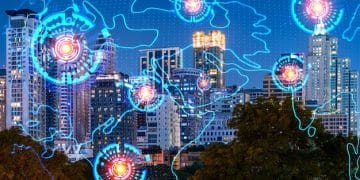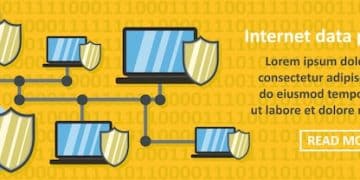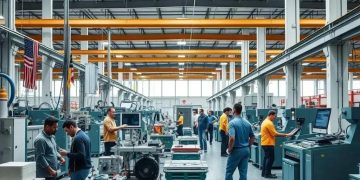The Future of Work: AI, Automation, and the US Job Market

The Future of Work: AI and Automation Are Reshaping the US Job Market significantly, impacting various sectors, necessitating workforce adaptation and reskilling initiatives to navigate the evolving landscape.
The rapid advancements in artificial intelligence (AI) and automation are poised to revolutionize the way we work. The future of work: how AI and automation are reshaping the US job market is becoming a central concern for businesses, workers, and policymakers alike.
Understanding the Rise of AI and Automation in the US
The integration of AI and automation into various industries is no longer a futuristic concept but a present-day reality. These technologies are transforming how tasks are performed, processes are optimized, and businesses operate in the United States.
What is AI and Automation?
AI refers to the ability of machines to perform tasks that typically require human intelligence, such as learning, problem-solving, and decision-making. Automation involves the use of technology to perform tasks automatically, reducing the need for human intervention.
Key Drivers of AI and Automation Adoption
Several factors are driving the adoption of AI and automation in the US. One is the increasing availability of data, which is essential for training AI models. Another is the decreasing cost of computing power, making it more affordable for businesses to invest in these technologies.
- Increased efficiency and productivity
- Reduced operational costs
- Enhanced accuracy and quality
- Improved customer experience
In conclusion, the rise of AI and automation in the US is driven by a combination of technological advancements, economic incentives, and competitive pressures. Businesses are increasingly adopting these technologies to improve efficiency, reduce costs, and gain a competitive edge.
The Impact on Different Sectors of the US Economy
AI and automation are not affecting all sectors equally. Some industries are experiencing more significant transformations than others, leading to shifts in employment patterns and skill requirements.
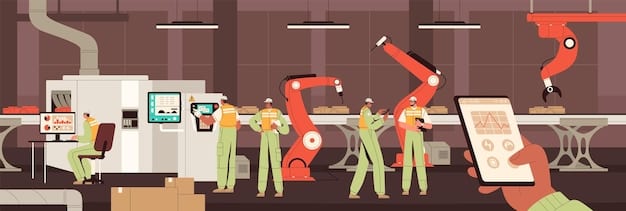
Manufacturing
The manufacturing sector has been at the forefront of automation for decades, and AI is further accelerating this trend. Robots are now capable of performing complex tasks, such as welding, painting, and assembly, with greater precision and speed than humans.
Healthcare
AI is transforming healthcare in various ways, from improving diagnostics and treatment to automating administrative tasks. AI-powered tools can analyze medical images, predict patient outcomes, and personalize treatment plans.
Finance
The finance industry is leveraging AI and automation to streamline operations, detect fraud, and provide personalized financial advice. AI algorithms can analyze large datasets to identify patterns and predict market trends.
- Retail: Enhanced customer service and supply chain management
- Transportation: Autonomous vehicles and logistics optimization
- Agriculture: Precision farming and automated harvesting
In conclusion, the impact of AI and automation varies across different sectors of the US economy. While some industries are experiencing significant job displacement, others are seeing the creation of new opportunities. Understanding these sectoral differences is crucial for developing effective workforce development strategies.
Job Displacement and Creation: Analyzing the Numbers
One of the most pressing concerns about AI and automation is their potential impact on employment. While some jobs may be displaced, new ones are likely to be created, leading to a shift in the overall job market.
Potential Job Losses
Several studies have predicted the potential for significant job losses due to AI and automation. These losses are likely to be concentrated in occupations that involve repetitive tasks, such as data entry, customer service, and transportation.
New Job Opportunities
While AI and automation may displace some jobs, they are also creating new opportunities in fields such as AI development, data science, and robotics. These new jobs often require specialized skills and training.
The Net Impact on Employment
The net impact of AI and automation on employment is still uncertain. Some studies predict a net loss of jobs, while others forecast a net gain. The actual outcome will depend on various factors, including the pace of technological change, the effectiveness of workforce development programs, and the adaptability of workers.
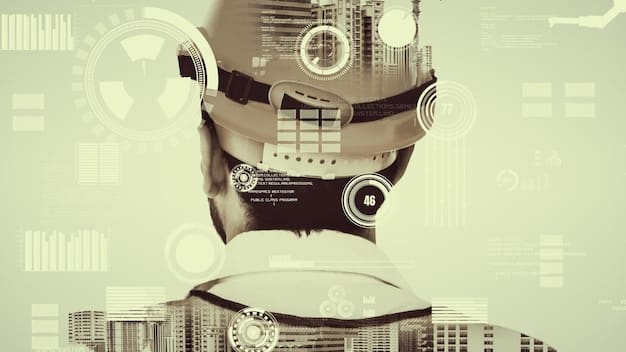
- Upskilling and reskilling initiatives
- Investing in education and training
- Promoting entrepreneurship and innovation
In conclusion, while there are concerns about job displacement, AI and automation also present opportunities for job creation. By investing in education, training, and innovation, the US can mitigate the negative impacts and harness the potential benefits of these technologies.
The Skills Gap: Preparing the Workforce for the Future
As AI and automation transform the job market, there is a growing need for workers with the skills to operate and maintain these technologies. This “skills gap” poses a significant challenge for businesses and policymakers.
Identifying the Skills in Demand
Some of the skills in high demand include data analysis, programming, and robotics. These skills are essential for developing, deploying, and maintaining AI-powered systems.
Addressing the Skills Gap
To address the skills gap, it is crucial to invest in education and training programs that equip workers with the necessary skills. This includes vocational training, apprenticeships, and online learning platforms.
The Role of Education Institutions
Education institutions, such as universities and community colleges, play a vital role in preparing the workforce for the future. They can adapt their curricula to incorporate AI and automation-related topics.
- Collaboration between businesses and educational institutions
- Investing in lifelong learning
- Promoting STEM education
In conclusion, bridging the skills gap is essential for ensuring that the US workforce is prepared for the future. By investing in education, training, and collaboration, the US can equip workers with the skills they need to thrive in the age of AI and automation.
Policy Recommendations: Navigating the Changing Landscape
Governments and policymakers have a crucial role to play in navigating the changing landscape of work. By implementing effective policies, they can mitigate the negative impacts of AI and automation and promote inclusive growth.
Investing in Workforce Development
One key policy recommendation is to invest in workforce development programs that provide workers with the skills they need to adapt to the changing job market. These programs should focus on upskilling, reskilling, and lifelong learning.
Strengthening the Social Safety Net
As AI and automation lead to job displacement, it is crucial to strengthen the social safety net to provide support for those who lose their jobs. This includes unemployment benefits, job training, and healthcare assistance.
Promoting Innovation and Entrepreneurship
To foster economic growth and create new job opportunities, it is important to promote innovation and entrepreneurship. This includes providing funding for research and development, reducing regulatory barriers, and supporting startups.
- Tax incentives for businesses that invest in training
- Public-private partnerships to address the skills gap
- Developing new models for social security
In conclusion, effective policies are essential for navigating the changing landscape of work. By investing in workforce development, strengthening the social safety net, and promoting innovation, policymakers can ensure that the benefits of AI and automation are shared by all.
The Ethical Considerations of AI and Automation
As AI and automation become more prevalent, it is important to consider the ethical implications of these technologies. This includes issues such as bias, privacy, and accountability.
Addressing Bias in AI
AI algorithms can perpetuate and amplify existing biases in data, leading to discriminatory outcomes. It is crucial to develop techniques for detecting and mitigating bias in AI systems.
Protecting Privacy
AI systems often collect and analyze vast amounts of data, raising concerns about privacy. Policymakers need to develop regulations that protect individuals’ privacy rights while allowing for the responsible use of AI.
Ensuring Accountability
As AI systems make more decisions, it is important to ensure that there is accountability for their actions. This includes establishing clear lines of responsibility and developing mechanisms for redress when AI systems cause harm.
- Developing ethical guidelines for AI development and deployment
- Promoting transparency in AI algorithms
- Establishing independent oversight bodies
In conclusion, ethical considerations are paramount as AI and automation become more pervasive. By addressing issues such as bias, privacy, and accountability, the US can ensure that these technologies are used in a way that benefits society as a whole.
| Key Point | Brief Description |
|---|---|
| 🤖 AI & Automation | Transforming industries, increasing efficiency. |
| 💼 Job Market Shifts | Displacing some jobs, creating new roles. |
| 🎓 Skills Gap | Need for upskilling and reskilling initiatives. |
| 🛡️ Ethical Concerns | Addressing bias, privacy, and accountability. |
Frequently Asked Questions
▼
The increasing availability of data and decreasing cost of computing power are key factors. Businesses also seek greater efficiency and reduced operational costs.
▼
Manufacturing, healthcare, and finance are heavily impacted. Retail, transportation, and agriculture are also experiencing significant changes through AI adoption.
▼
Investing in education and training programs is crucial. This includes vocational training, apprenticeships, and online learning platforms to equip workers with needed skills.
▼
Workforce development programs and strengthening the social safety net are key. Promoting innovation and entrepreneurship also helps create new job opportunities.
▼
Addressing bias in AI, protecting privacy, and ensuring accountability are crucial. Ethical guidelines and transparency are essential for responsible AI development.
Conclusion
The future of work: how AI and automation are reshaping the US job market is a complex and multifaceted issue. As these technologies continue to advance, it is essential for businesses, workers, and policymakers to adapt and collaborate to ensure that the benefits are shared by all.

